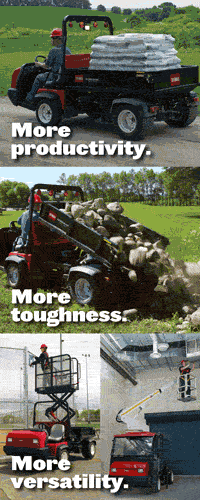 Heavy-duty utility vehicles can be valuable to any grounds crew in transporting workers, tools and heavy payloads, providing access to areas not accessible by road, and getting the job done efficiently without impact to the turf. Heavy-duty utility vehicles can be valuable to any grounds crew in transporting workers, tools and heavy payloads, providing access to areas not accessible by road, and getting the job done efficiently without impact to the turf.
Some examples of the above versatility include:
- At a golf course, the superintendent occasionally needs to apply growth nutrients and pesticide chemicals to the turf, while done with a machine that can also meet day-to-day job requirements such as hauling rocks, tree limbs, or bunker sand.
- At a university or professional sports complex, the turf manager needs to haul heavy loads of infield dirt or warning track material, but also needs to groom the infield to ease compaction and ensure consistent surface playability, as well as remove trash for improved aesthetics.
- After a thunderstorm, the municipal worker might need to repair power lines, traffic signals or signage.
- On a construction project, the crew must transport heavy materials across terrain that may be muddy, rocky, undulating or otherwise challenging.
- An industrial refinery has the need for a highly maneuverable vehicle to navigate tight areas in the refinery compound, along with a heavy payload capacity for transporting materials.
- And, at a cemetery, workers must transport caskets to the burial plot.
This list could go on, but suffice to say there are hundreds of different grounds and facility maintenance jobs that can be performed by a heavy-duty utility vehicle, especially when combined with the attachments provided by manufacturers or third party suppliers.
In addition to the customer’s need for transport and increased hauling capacity, other requirements include improved durability, ride comfort, and fuel economy. Toro has responded to the many needs of customers today with the new Workman® HD Series of heavy-duty utility vehicles. These machines deliver the work productivity customers demand, including industry-leading total vehicle payload and towing capacities, improved fuel efficiency, superior ride quality and ergonomics.
The Workman HD Series includes design elements such as an I-beam shaped DeDion rear axle, a truss-like front space frame, integrated wheel bearings, and 4-wheel hydraulic disk brakes - all integrated to provide the highest total carrying capacity in its product class and to tackle the toughest jobs. The DeDion axle is built with the same kind of I-beam design that is used for skyscrapers in the construction industry. It gives the Workman superior vertical loading capacity by isolating the engine, transmission and main frame from all load forces. The truss-like front space frame provides superior strength and rigidity, and the rear frame has a C-channel design for unsurpassed performance in its class for hauling heavy loads. The advanced integrated wheel bearing technology is a feature that is prominent in automotive sport utility vehicles, and keeps the vehicle rolling under the heaviest of loads – job after job. Advantages such as enhanced sealing and precise manufacturing tolerances deliver benefits that include simple servicing and longer life
The Workman HD model comes with a 23hp Kohler® air-cooled gasoline engine; while HDX models feature either the 24hp Briggs & Stratton® Daihatsu® diesel engine or the 31hp Briggs & Stratton Daihatsu engine with electronic fuel injection (EFI), along with the option of two- or four-wheel drive. EFI is standard in the automotive market and is fast becoming the standard for all-terrain and utility vehicles. A key benefit is ease of instant engine starting in both warm and cold weather conditions. The EFI system delivers fuel directly to the engine, so you don’t have to apply a choke to start or warm up the engine. Fuel is injected ahead of the intake valve and directly into the intake manifold, which controls the mixture of air and fuel. The regulators and sensors in an EFI system are more precise than traditional carburetion systems.
EFI is typically 15-20% more fuel efficient than carburetor engines and delivers fuel to the engine more precisely. By utilizing the high pressure fuel injector and sensors to detect engine fuel requirements, EFI gives the engine exactly what it needs for adequate power with little waste of fuel. This power is consistent and smooth for speed and acceleration throughout the throttle range. EFI engines are quieter and produce lower levels of emissions, and meet 2011 EPA compliance and California Blue Sky regulations. In addition to fuel cost savings, less maintenance and mechanical adjustments are required with the elimination of the choke and carburetor, as well as on-board diagnostics that provide easy troubleshooting for the technician.
A comfortable operator is a more productive operator. The HD Series delivers optimum operator comfort even in undulating terrain through its innovative suspension system. Front suspension consists of an independent, double A-frame with opposing dual coil springs and shock absorbers, and rear suspension consists of the DeDion rear axle with dual leaf springs and shock absorbers. Four-wheel hydraulic disc brakes also bring safety benefits and are easier to service than traditional drum brakes.
Versatility is where heavy-duty utility vehicles widen the “total cost of ownership” advantage vs. pickup trucks or skid steer loaders. Attachments such as topdressers, sand and fertilizer spreaders, 200-gallon chemical sprayers, aeration core sweepers, aeration core processors, infield groomers, synthetic turf conditioners, casket transporters, aerial vertical lifts, and deluxe hard cabs add tremendous versatility to this work platform. Any of the above attachments can be added to the Workman HD Series utility vehicle in a matter of minutes for specialized jobs and are all relatively easy to operate with proper training and review of the Operator’s Manual. Heavy-duty utility vehicles allow customers to work smarter with greater productivity and efficiency.
Information courtesy of The Toro Company
|
 Facility Care and Optimization Newsletter from Maintenance Solutions
Facility Care and Optimization Newsletter from Maintenance Solutions  Facility Care and Optimization Newsletter from Maintenance Solutions
Facility Care and Optimization Newsletter from Maintenance Solutions